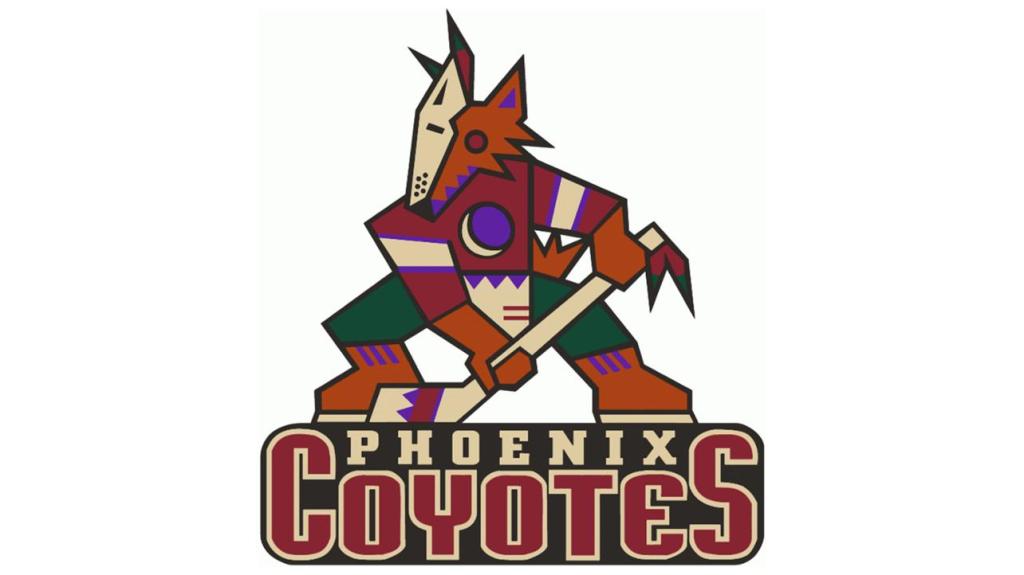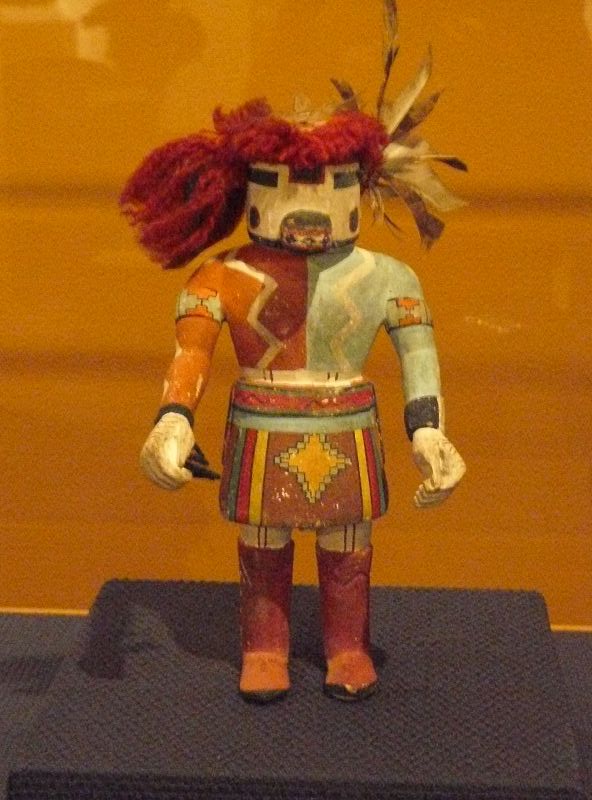
Co-Authored with Dr. Natalie Welch. Dr. Welch (@rerunnat) identifies as a member of the Eastern Band of Cherokee Indians and is an Assistant Professor of Business (Sport Management) at Linfield University.
This year, the Arizona Coyotes decided to revive their old Kachina coyote logo. The last time the team wore the Kachina coyote as its primary logo was back in 2003. According to ESPN, “It was based on the ancestral spirits of the Pueblo people and depicted a hockey-stick-wielding coyote with a patchwork of colours associated with the Southwest, including green, brick red, sand, and purple.” Last year, the Kachina coyote was voted the “greatest logo in Arizona sports history.” Coyotes CEO and President, Xavier A. Gutierrez thinks that the logo represents “inclusion”: “There’s something about the logo that people outside of hockey really gravitate to. It’s colorful and unique.” The only real way to read that statement is to admit that hockey team logos, in general, are bland and generic (save for the Kraken, obviously).
Unfortunately, the story of how the Kachina coyote came to be is rather exclusive. Greg Fisher, who designed the logo, explained how it was conceived:
Colorful and symbolic Kachina artwork is based on the supernatural beings in the beliefs of the Pueblo peoples. A Kachina is not necessarily worshipped as a diety, but rather as an ally and a connection to the forces of nature….Fisher worked closely with the organization’s first ownership group – Jerry Colangelo, Richard, Burke, and Steven Gluckstein — along with David Haney, the NHL’s creative director at the time…[The NHL’s Haney] flew in one day and we were in Colangelo’s office with some Kachina dolls, and he said, “Talk to me about the heritage of those,” [motioning toward the dolls]. We built a brand story around that, and it sort of evolved from there….Fisher and Haney recalled seeking and getting the approval of Hopi leaders in Arizona before the final Kachina-style logo was made public.
NHL.com
To summarize, a group of (seemingly) white men sat around a table and created a logo from some spiritual dolls that was supposed to capture local Indigenous culture. Then they asked said Indigenous people to approve their creation. While the idea of creating a logo that speaks to local Indigenous groups and cultures is a valid idea, to do this without Indigenous people in the room is the definition of cultural appropriation. And no, the “final approval”received in the 1990s is not good enough because when the revived logo was revealed this year, Stewart Koyiyumptewa, head of the Hopi Cultural Preservation Office stated, “I am really concerned about this because the Hopi Tribe is still a living cultural group that practices the kachina ceremony.”
Cultural appropriation refers to the act of taking from traditionally marginalized communities without proper acknowledgement or relationships. This taking can include art, dance moves, food, language, and hair styles, as some examples. It is taking without giving credit. It is also the privilege of taking something “cool” and not having to deal with any of the racism that others might have to experience. For example, kimchi has become “trendy” food found in everything from grilled cheese sandwiches and pizza, to hot dogs and quesadillas. But left behind are all the Korean children who were made fun of at school because their lunches “smelled funny,” and the Korean people who get lumped into broader strokes of anti-Asian hate. To put it simply, cultural appropriation is loving the culture and leaving the people behind. The “cool thing” becomes separated from its histories and people so that it can be marketed to the masses.
To understand the specific history of the Kachina dolls, Helga Teiwes writes in “Kachina Dolls: The art of Hopi carvers“:
Tithu, or kachina dolls, are small, carved wooden resentations [sic] of the Katsina. A kachina doll is not a Katsina, a spirit; the word doll, although inexact should always be used to differentiate between the object and the spirit. A kachina doll in itself is not idolized or worshipped, but it does require respect, and if given by a Katsina as a prayer, it belongs traditionally within the realm of Hopi religious ritual. The fact that it is, in Hopi belief, made and given by a Katsina establishes a link to the spiritual world and thus represents well-wishing for the recipient. Seldom played with, these dolls, which usually have no bases to stand on, are hung on the wall of the family room, where they remain, treated respectfully, as blessings to the girl to whom it was given and her family. (p.33)
James Baras, a buyer of American Indian Art for the Heard museum told AZ Central, in reference to the Kachina logo, “I guess it depends on what capacity or how it’s used, but it is a part of their religion, like having a Jesus Christ on your jersey might ruffle a few feathers.” He continued, “You’re going to have some Hopis who don’t care if a Kachina face or name are associated with a sports team, but I think most of them will probably be somewhat sensitive.” To his point, you’re never going to find consensus with an entire group of people. Even if the Hopi leaders did provide approval for the first logo there was no relationship established and this logo contributes to a long list of Native American practices, artifacts, and likenesses that have been used to reproduce the colonization and oppression of Indigenous peoples.

The Hopi continue to live in the area now known as Northern Arizona. Teiwes explains, “The Navajo named these people the Anasazi, the Ancient ones. Like their ancestors, the Hopi are masters of survival. Many outsiders have marvelled at their ability to grow enough food to feed hundreds of people for centuries in this harsh and dry environment, where the annual rainfall is twelve inches or less” (p. 1). In the early 1900s, Hopi ceremonies were sold as tourist attractions for those visiting the Southwest United States by train: “Hordes of photographers sought to out-do each other for the best shots while intermingling with Katsina dancers. To these outsiders the very essence of Hopi life and culture was but a casual entertainment….Hopi perseverance won out once again. Hopi elders protested, and for the last seventy years no photographs have been allowed to be taken at any ceremony. The reaction has gone so far in recent decades that whole villages are closed to whites from time to time, and non-Hopis may no longer attend certain plaza ceremonies” (p. 30).
Current Hopi leader Koyiyumptewa further explains about the Arizona Coyotes logo, “It’s a disturbance when you have a half coyote figure with a mask. That’s really revealing in my opinion. If they were to use this logo, we would prefer for it to not be half masked. That’s something we would have brought up if they were to have reached out to the Hopi Tribe, but they simply didn’t do that.”
The Arizona Coyotes are not only appropriating but they are continuing the marginalization and flat out erasure of Indigenous peoples. In discussing the rebrand, Gutierrez said, “We not only want to focus on our fans, but also on our fans in waiting. In our research, we found that the logo resonates with people who aren’t hardcore Coyotes fans or hardcore hockey fans. That includes families and young females. It includes diverse communities, like Latina, African American and Asian communities.” Nary a mention of the Indigenous communities from which their “inspiration” was drawn.”
The media have a role to play in this continued appropriation as well. In AZ Central’s own reporting they call themselves out for not asking the right questions or adding to the discussion on previous occasions:
We wrote about the logo in 2020 when it was selected as the best in Valley sports history, but the reporting didn’t reflect a conversation on appropriation. We wrote about it again a few weeks ago when the club announced plans to expand the use of the design, and again there was no mention of whether it was appropriate for the club to profit from a living religious tradition.
As the largest media operation in the state, we need to do better by all of our residents, particularly Native people who have been overlooked, erased and ignored throughout their history.
Koyiyumptewa welcomes dialogue with the Arizona Coyotes but it doesn’t seem like this connection has been made yet. He said, “If they would have reached out to us, maybe we could have offered some prayers for their success, but they haven’t reached out.”


